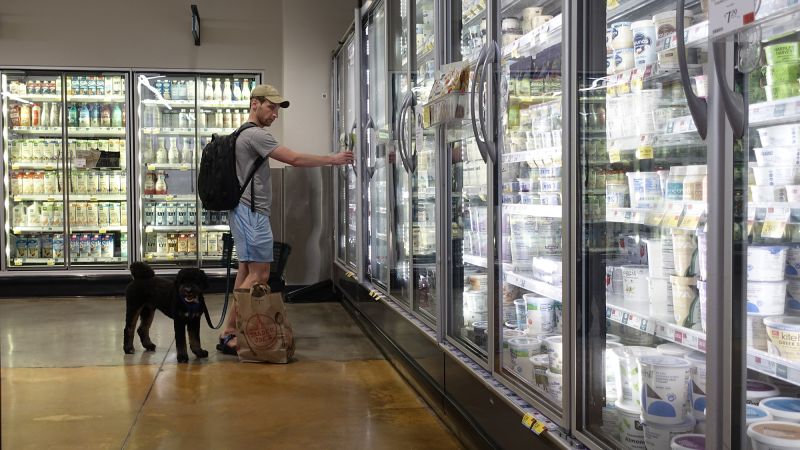Vice President Kamala Harris has picked up the baton from President Joe Biden on the fight against so-called greedflation – the notion that the United States’ inflation crisis was exacerbated by excessive corporate profit-taking that marked up goods or shrunk their sizes and padded businesses’ bottom lines.
Is there any truth to those claims? Sure, some.
“We all know that prices went up during the pandemic when the supply chains shut down and failed, but our supply chains have now improved and prices are still too high,” Harris said during a speech about the economy Friday in North Carolina. “Many of the big food companies are seeing their highest profits in two decades. And while many grocery chains pass along these savings, others still aren’t.”
“I know most businesses are creating jobs, contributing to our economy, and playing by the rules, but some are not, and that’s just not right, and we need to take action when that is the case,” Harris said.
But the Harris and Biden fight against greedflation and price gouging ignores three fundamental truths: Consumers play a pivotal role in the price of goods. Inflation had many causes, but corporate greed was not a primary factor. And the war on inflation has largely been won already.
Make no mistake, some of the biggest food companies are raking in big fat profits. But here’s the kicker: Many reported even bigger profits when inflation was much lower.
Take, for instance, PepsiCo. Last year, the company reported earning a very solid $9.1 billion in profit. That’s $2 billion more than what it made in 2020. But it’s still below the $12.5 billion profits it earned in 2018, when prices were rising at an annual pace below 3%. Similarly, Kroger, one of the nation’s largest supermarket chains, earned a bigger profit in 2018 compared to 2023.
Kraft Heinz, meanwhile, made $10.9 billion in 2017. That’s almost four times as much as it earned last year.
So Harris’ claim doesn’t quite hold up on the whole, though there are some recent examples where charging consumers more has fed higher corporate profits. Cal-Maine Foods, the largest egg producer in the US, saw its revenue double and profit surge 718% in the first quarter of last year because of sharply higher egg prices.
“Vice President Harris believes it is wrong for bad actors to rake in record profits on the backs of increasing prices on consumer goods,” a Harris-Walz campaign spokesperson told CNN.
Supply and demand
Before the hate mail piles up, let’s state the obvious: Wall Street’s gonna Wall Street. Companies will find any way and any reason to make more money off of customers. Big business is not your friend.
So, yes, shrinkflation – that sneaky practice of keeping the price the same but shrinking the product – remains an annoying tendency. And greedflation is for sure a thing. We’re not just saying that: The San Francisco Federal Reserve had a whole study on it in May, and it noticed unusual price spikes that weren’t supported by the market for gasoline, cars, repair costs, laundry and personal care, among some other goods and services, when inflation started to spike in 2021.
But here’s the thing: The US economy is not just a few markets. It’s a massive $29 trillion beast. In aggregate, corporate profit taking was not a leading cause of inflation – according to that same San Francisco Fed study. Those price markups in certain sectors weren’t out of the ordinary – and measuring the economy as a whole, greedflation was basically nonexistent.
It’s always good to have a Fed study to help make your point, but it doesn’t take super smart economists to explain the case against price gouging as a leading cause of inflation. It’s really just Econ 101: Supply and demand set prices – not companies alone.
And there’s no better evidence of that than what’s happening in retail right now: After years of rising prices, companies across the board in their quarterly financial calls with Wall Street analysts have said some customers are refusing to pay higher prices – so companies like Target, Starbucks and McDonald’s have cut prices and added deals to bring customers back.
Rents have also come down in recent months because of a glut in new rental housing. That’s led a growing number of landlords to offer perks like a month of free rent or free parking to get people to sign on the dotted line.
Good ol’ supply and demand.
So if it wasn’t mean corporations, what actually caused inflation to spike?
The story starts with Covid throwing the global economy into turmoil. The pandemic temporarily shut down the production of goods and created massive supply and demand imbalances.
Many nations, including the United States, effectively turned their economies off for a short while and pumped trillions of dollars of stimulus into the economy to support businesses and workers. That gave workers an extra cushion in their bank accounts that artificially boosted consumer spending – a phenomenon that would last for several years.
The Federal Reserve joined those efforts to boost demand across the economy by bringing interest rates down to near-zero levels for two years. That locked in wealth for generations, as Americans snatched up homes with a 30-year mortgage rate of just 2% to 3%. And those who had already bought a home were able to refinance at a similar rate.
This all created the perfect storm for prices to shoot through the roof.
Then, came Russia’s invasion of Ukraine, which exacerbated the snarled global supply chain problem, driving prices even higher. And disruption and chaos in the Middle East sent oil higher for a while, too.
No one likes paying higher prices, and polling consistently shows Americans hold a negative view of the economy because of inflation. But that’s no longer the economy’s biggest concern.
Inflation has moderated so much that economists are now worried about jobs, not prices. After spiking above an annual increase of 9%, consumer inflation has fallen below 3% to a three-year low. A different measure of inflation, the Federal Reserve’s preferred Personal Consumption Expenditures price index, has fallen to within a half percentage point of the Fed’s target of 2% inflation.
That means attacks on greedflation and price gouging, though perhaps good politics, may be bad policy. In fact, Harris’ plan to cap certain prices could create more problems than it solves, several economists told CNN.
Corporations cannot be trusted to be good actors – that’s why regulations exist. But the war on inflation has been won. Consumers have spoken. Taking action now probably isn’t going to help much.
Read the full article here




